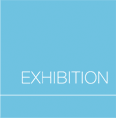|
Cloth & Culture NOW
the artists - Michael Brennand-Wood, UK
The Ties That Bind
The defining characteristic of my work
has been a sustained commitment to the conceptual synthesis
of contemporary and historical sources. In this respect I have
persistently worked within contested areas of textile practice
embroidery, pattern, lace and recently floral imagery. Sites,
which offer unbroken traditions, cross cultural connections and
a freedom to work outside the mainstream. Personally, I’m
interested in understanding the connections between the information
I collate, the reason’s I associate one material
with a specific idea,, instead of something which would appear
initially to be a more logical choice. The adventure is to discern
why and make sense of the clues amassed.
The two primal materials in my work, textile and wood relate directly
to my maternal Grandparents. My Grandmother worked in an industrial
mill in Lancashire, as a young woman, weaving cloth for the cotton
industry. As a child I literally played with cloth, learning to
sew and knit before the age of 10. This positive introduction to
fabrics and technique meant I never viewed textiles at college
as exclusively female; it was simply another area of visual expression.
In 1970 at Art School, textiles seemed to offer unlimited possibilities,
analogous in my mind to the advent of abstraction in 1910.
My Grandfather was an engineer, introducing me to wood and metal-based
technologies. As a young child I vacillated between both my Grandparents
constructing all manner of objects and artworks. This early introduction
to textiles and wood developed an appreciation of dualities; I
enjoy the frisson that emanates when unexpected materials are combined.
In later life I came to understand that my grandfather’s
family had worked as dye and wood block artisans. Retrospectively,
I discovered an authenticated textile past one that, particularly
in the reference to the printers wood block has a direct parallel
to my research into lace beginning with ‘Hide and Seek’ from
1992 onwards. Virtually all of the subsequent lace works utilized
a process in which fabric is inlaid into a carved wood surface.
Inlaid fabric is suggestive of archaeology, information embedded
within a stratification of paint and wood. Factor in fabrics, with
specific mnemonic qualities and a powerful laminate is created.
Apart from our mothers skin, fabric is the first material we encounter
in this world, is it any wonder that our responses to fabric in
later life, are so emotionally charged with memory? Cloth is literally
saturated with meaning; it charts our passage through life, records,
documents and celebrates our personalities. It is a tactile record
of associative experiences and sensory triggers.
Artistically, textiles provide a material, technical and cultural/historical
framework within which to develop ideas. The ‘Ties that Bind’ completed
in 1996, utilised clothing from 2 people, male and female Compositionally
the work references board games as a symbol of life’s choices
and memory quilts from America. A group of quilts that re cycled
and reconfigured clothing into a fabric that became a record of
one family’s evolution.
In 1996 ‘Material Evidence’ subtitled ‘Improvisations
on a Historical Theme’ opened at the Whitworth Art Gallery,
Manchester, curated by Dr Jennifer Harris. Visiting the gallery
I was specifically drawn to a group of early Italian lace held
within the Whitworth permanent collection. This was my opportunity
to work from primary as opposed to secondary source material. My
proposal was to make 6 large-scale works based upon my research
of the above group of Italian 1600-century lace. Of equal importance
was the opportunity to influence the perception of textiles, as
the work of dead people. As a contemporary Artist, I wanted to
force a questioning of this pejorative criticism and illustrate
that historical textiles could provide a rich site of cross cultural
and associative significance that had as much relevance today as
any other potential source. The imagery and context of the
examples selected were crucial in illustrating that textiles should
not be viewed as simply beautiful or decorative. Core images could
be rendered in a completely unexpected scale. media and form. One
important aspect of the final display was the positioning of the
original lace fragments adjacent to the new pieces. We wanted the
audience to work at understanding what had been referenced and
what had been edited out. Of equal importance was the opportunity
to view how additional reference material had been introduced some
of which had little if anything to do with textiles. Underscoring
once again that textiles is a living tradition, it reflects the
makers interests and place in time.
Textile patterns, in particular are conveyers of human experience, cultural
interaction and identity. Patterning is an encoded visual language constantly
morphing via trade and migration. Indigenous patterns hybridize into new configurations.
The study of patterns reveals much in anthropological terms about our spiritual
cultural and sociological history.
Patterning, specifically floral imagery increasingly came to fascinate
me in 2001.Textiles historically have referenced floral imagery
i.e. William Morris, Art Nouveau, Caucasian Rugs, Batiks, Suzani
Fabrics etc. My response to floral imagery at college was one of
distain; we were expected as textile students to draw flowers.
I was interested at that time in Robert Rauschenberg, John Cage,
Minimal Music, I had no empathy whatsoever with a plant. My research
however, into historical textiles kept returning me to the inevitable
conclusion that I would have at some stage to interpret this endemic
connection. My solution was to subvert this tradition via a process
of using real flowers not as a source image but as media, I would
literally draw with flowers. ‘Stars Underfoot’ a series
of large photographic prints began this process in 2001, a residual
memory of a textile was improvised using real flower heads, The
work was by definition temporary and the photograph became the
only record of that process. Having got to this stage and excited
by the results it seemed inevitable that I should now move back
into constructing a textile. The evolutionary nature of this process
had great symbolic appeal, as it seemed to enforce my awareness
of the cyclic nature of textiles influence. ‘A Field of Centres’ which
opened in 2004, illustrated this transposition from the real flowers
to the photographic images into almost holographic computerised
machine, mixed media, and relief’s. As is always the case
in my work, which is serial in development additional, references
crept in, once again reinforcing the organic cause and effect of
responding to that which impacts upon practice at a given period
of time.
Clearly I acknowledge trans cultural influences in my practice.
Travel has provided the most instructive form of professional development.
From the mid 1980’s I have undertaken major residences in
many countries of which Japan, Australia, New Zealand and Canada
would be the most significant. I’ve always been drawn to
the idea of continuous education; I believe the most interesting
artists locate themselves within unfamiliar territory. Habitat,
studio, material choices and imagery have all been influenced via
travel, the beauty of which is the unfamiliar. Influences are not
confined to an obvious place, locality association. I first became
interested in Italian Lace after I bought a book in a Western Australian
bookshop. That’s the source I went home with, not in anyway
a desire to reference red sand or arid desserts.
Contact with other Artist’s is important, Recognition of
your work by others is beneficial, it creates new opportunities,
allows for transference of shared concerns and aspiration. It also
opens your practice to a much wider critique and ultimately drives
ambition. Equally, exposure at first hand to the work of Artist’s
you respect, of which Japan is the most obvious causes you to develop
new strategies in relation to materials, form and content.
It would be easy in one sense, to reference major areas of influence,
in my case lace floral imagery patterning. Areas, which are defined,
and outcomes clearly related and cognate. Traditions filter through,
practice in less discernable forms as of course they do, in real
life, we are not always aware of what we are doing as we proceed
Rebecca West once said that ‘she wrote to find out what she
thought’ a statement that substantiates thinking through
making as opposed to illustration of concept. The following is
a collection in some measure of some, not all, of the auxiliary
qualities, insights I have been fortunate to experience as I have
interacted and worked with textiles history.
The study of carpets and textiles from Central Asia and the Far East
has reinforced my belief that textiles intrinsically utilise loose geometry
as a structural device. By that, I am referring to the fact that no geometrical
textile is ever absolutely perfect. For me this enhances reverberation, the
colours, patterns within the visual field shimmer, modulate, referencing the
imperfection / perfection of natural sources. There is the pragmatism of what’s
at hand to use, materials are recycled, hybridized. Cloth from one place can
be used in a completely unexpected and inventive way. Information is handed
down via tacit methodologies, precipitating change by default. Mistakes in
textiles and I’m reluctant to use that phrase, invariably are seen as
a signpost to a new space. Because imagery is passed down, via the hand it
allows space for something new to happen, it’s a living tradition and
any living textile artist is part of something that goes back into time. I
also believe through experience, that materials have a spirit. Artists should
be responsive to the inherent qualities of materials and use accordingly, an
insight derived expressively, from looking at and handling Japanese textiles,
artyfacts. There are of course traditions within your own practice, a fact
that becomes clearer as you get older, you cross reference or re- introduce
aspects of your own visual language, as and when appropriate. There is constant
evolution, material choices, references to past iconography that is updated,
re-synthesised, when appropriate.
I feel fortunate, to have been given the opportunity, to work within
an area that allows insight to be tacitly experienced, qualities
that are not discernable from the printed page. Textiles are, if
nothing else about the accessing of information via sensory engagement,
touch, feel, scent, sight, sound. We understand deeper levels of
meaning in greater depth, through the employment of both our sensory
and intellectual selves. Emotion is by definition unpredictable;
textile traditions are intrinsically related to the human condition
in all its messy splendour, all aspects of life are recorded. Textiles
are not solely concerned, with aesthetic considerations. It is
this human outsider quality, which constantly, draws me back, the
search for another clue, insight connection that may be discerned
in the most unexpected quarter.
There is an old Sufi saying:
‘Thought that is planned is tradition’
‘Thought that is unplanned is imagination’
‘Thought that is both is spirit’
Textile traditions for me are not enough; I’m not interested
in heritage culture re-workings of existing ideas, however beautiful
or exciting. I seek an infusion of both history and experience
born out of my life on this planet. The past is instructive, it
provides insight and an opportunity to share communal concerns;
it roots my practice within a global framework facilitating comparison,
it gives me support in the sharing and discussion of ideas. In
order for my work to have relevance within the here and now it
must also synthesize thought and expression that reflects my time.
If you get that right I believe you are creating something, which
has the possibility to transcend the obvious and reach into the
unknown, a marker for future generations to puzzle over.
UK
|









